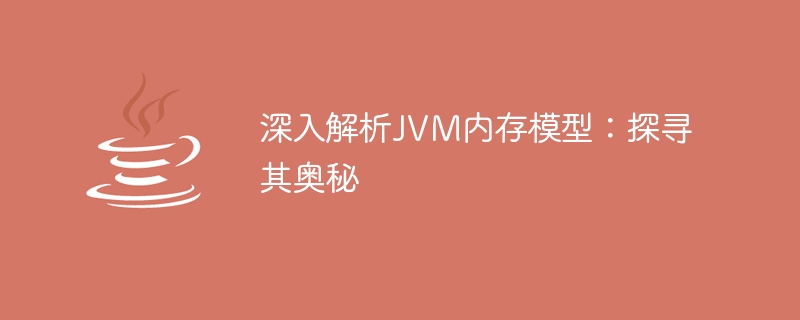

In-depth analysis of the JVM memory model: To explore its secrets, specific code examples are needed
1. Introduction
Java Virtual Machine (JVM) is the Java language The core is responsible for core functions such as program running and memory management. The JVM memory model means that during the running process of the JVM, the memory is divided into different areas for storing different types of data. Understanding the working principle of the JVM memory model can help developers better optimize program performance and avoid problems such as memory leaks. This article will provide an in-depth analysis of the JVM memory model from beginning to end, and help readers gain a deeper understanding of its working principles through specific code examples.
2. Components of the JVM memory model
The JVM memory model consists of the following parts:
3. Specific implementation of the JVM memory model
The following is a specific code example that demonstrates the implementation process of the JVM memory model:
public class MemoryDemo { public static void main(String[] args) { int a = 1; int b = 2; int c = add(a, b); int d = multiply(a, b); System.out.println("c = " + c); System.out.println("d = " + d); } public static int add(int x, int y) { return x + y; } public static int multiply(int x, int y) { return x * y; } }
In the above code , we define aMemoryDemoclass and define four variables in themainmethod:a,b,c,d. We called two methods,addandmultiply, to implement addition and multiplication operations respectively, and assigned the results tocanddrespectively. Finally, output viaSystem.out.println.
First of all, when the program starts, the JVM will automatically allocate a piece of heap memory to the instance object of theMemoryDemoclass, which contains themainmethod andThe bytecode information of the two methods addandmultiply.
When themainmethod is called, the JVM will create a stack frame and push the stack frame into the virtual machine stack. The stack frame contains the local variable table, operand stack, dynamic link, method exit and other information of themainmethod.
In themainmethod, we assign values toaandbrespectively, and calladdandmultiplymethod. At this time, the JVM will create two stack frames respectively and push the stack frame into the virtual machine stack. In the stack frame of the
addmethod, memory will be allocated forxandy, andaandwill be allocated The value of bis passed to these two variables. After theaddmethod is executed, the return value will be saved in the stack frame and passed toc. In the stack frame of the
multiplymethod, memory will also be allocated forxandy, andaand ## The value of #bis passed to these two variables.multiplyAfter the method is executed, the return value will be saved in the stack frame and passed tod.
canddthroughSystem.out.println.
The above is the detailed content of Demystifying the JVM memory model: in-depth analysis. For more information, please follow other related articles on the PHP Chinese website!




